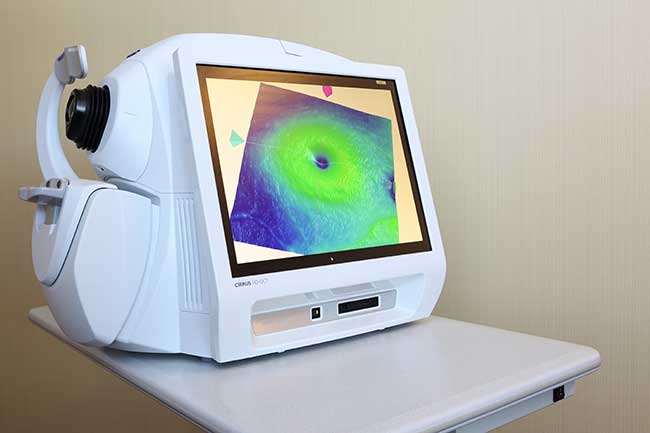Corneal Transplant
Rutzen EYE SPECIALISTS & LASER CENTER
What is a corneal transplant?
A corneal transplant is procedure in which a cloudy or misshaped cornea is removed and replaced with a clear, donated cornea. The cornea is the clear outer layer on the front of the eye. The surgery is done to improve your vision. Penetrating keratoplasty is another name for this procedure.
What are some causes of corneal clouding or injury?
Common causes of corneal clouding or decreased vision from corneal problems are:
- Fuchs corneal dystrophy, which is a common condition that can run in families and causes swelling and clouding of the cornea
- keratoconus, where the cornea becomes increasingly misshapen
- operations on the eye, especially cataract surgery
- conditions that cause scarring, like cuts, burns, or infections
- eye diseases that started at birth.
Where does corneal transplant tissue come from?
Corneas for transplant come from other people who have donated their corneas. An eye bank examines, protects, and stores the donated corneas. Before a donated cornea is used, it is tested for clarity and diseases. Only clear, healthy corneas are used.
How do I prepare for the procedure?
Arrange for someone to take you home after your surgery.
Follow your healthcare provider’s instructions about not smoking before and after the procedure. Smokers heal more slowly after surgery. They are also more likely to have breathing problems during surgery. For this reason, if you are a smoker, you should quit at least 2 weeks before the procedure. It is best to quit 6 to 8 weeks before surgery. Also, your body will heal much better if you do not smoke after the surgery.
If you are taking daily aspirin or other blood thinners for a medical condition, ask your provider if you need to stop taking the medicine before your surgery. If you need a minor pain reliever in the week before surgery, choose acetaminophen rather than aspirin, ibuprofen, or naproxen. This helps avoid extra bleeding during surgery.
The day of the surgery, you should not eat or drink anything before the procedure. If you regularly take any important medicines, your provider may ask you to take them on the day of surgery with a sip of water.
What happens during the procedure?
Often a general anesthetic is used. A general anesthetic relaxes your muscles, puts you to sleep, and prevents you from feeling pain. Sometimes a local anesthetic and sedative are used instead. The local anesthetic numbs the eye and the sedative relaxes you.
The center of the cloudy or damaged cornea–an area about the size of a dime–is removed. Then the clear center of a donated cornea is sewn into its place using stitches that will be removed later. If your eye has a cataract, the cataract can be removed at the same time.
In a newer type of corneal transplant, only the deeper layers of the cornea are removed and replaced with donor tissue. This is called deep lamellar keratoplasty. Ask your doctor if you are a candidate for this procedure.
Your eye doctor will put a patch over your eye. You will be able to go home when you are fully awake, 1 to 2 hours after the surgery.

What happens after the procedure?
Your doctor will examine your eye the next day. There is usually very little discomfort after surgery. You may feel like you have something in your eye for a few days.
Avoid bending, heavy lifting, and exercise for at least 2 weeks. Wear glasses or a shield at all times to protect your eye. You will use eyedrops several times a day for a long time. They help prevent infection and rejection of the new cornea.
As the eye heals, some of the tiny stitches used to sew the transplant in place may be removed. This is done easily and painlessly in your doctor’s office. The stitches may be removed as early as a month after surgery or up to a year later. Sometimes the stitches are left in place permanently. Sometimes a stitch may break or loosen on its own. You will feel like there is an eyelash under the lid. You should let your doctor know because it may need to be removed.
It takes time for good vision to return after this surgery. You will probably get new glasses or contact lenses 4 to 6 months after surgery.
Sometimes an eye has some astigmatism after surgery. This means the cornea is uneven. Sometimes this is due to the stitches used during corneal transplant surgery and can be fixed by removing some of the stitches. Astigmatism can cause blurred vision, but glasses or contact lenses usually can correct it. In the few cases where there is too much astigmatism to correct with glasses or contacts, more surgery may help.
What are the benefits of this procedure?
If the surgery is successful, your vision will be clearer than it was when you had a cloudy or injured cornea.
How successful the surgery is depends on the reason for having the transplant and the overall health of your eyes.
What are the risks of surgery?
Rarely, a serious infection or bleeding can permanently damage your eyes. Your eye doctor will take every possible precaution to prevent this.
Another risk is that an injury to an eye with a corneal transplant can cause more severe damage than injury to an eye without a transplant. This is because the stitches are not as strong as natural tissue.
A few people with corneal transplants have a graft failure. This means that the transplanted cornea becomes too cloudy to allow good vision. This may happen, for example, because the body rejects the new cornea. Uncontrolled high pressure in the eyes, a history of inflammation in the cornea, and abnormal blood vessels in the cornea are some things that increase the risk of graft failure. In general, the reason for needing a corneal transplant and the overall health of the eye determine how successful a corneal transplant will be.




